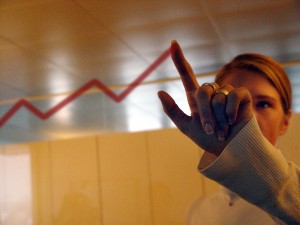2010 Economic Outlook: Where has all the optimism gone?
The Great Recession ended during the third quarter of 2009; why aren’t we all more optimistic about 2010?
Looking Back at the Great Recession
By Marney Cox
All recessions are temporary, including the “Great Recession” that began in December 2007. Most economists believe this recession ended some time in the third quarter of 2009. For example, the nation’s Gross National Product (the value of all goods and services produced in the economy during the year) rose by 2.8 percent (annual rate) during the third quarter of 2009, after declining for four quarters in a row; a good sign the recession has ended. However, the havoc created by the recession is expected to be around for a while and it will leave some lasting impacts.
Over the course of the recession, we witnessed a record number of jobs lost, about 7.4 million nationwide and 76,400 locally; the unemployment rate doubled, rising to 10 percent nationwide and 10.3 percent locally (November 2009); the average length of time a person remains unemployed rose nearly 70 percent to 28.5 weeks; real consumer spending fell by 1.7 percent and business investment slid a hair-raising 28 percent. From their pre-recession peaks, home prices have fallen 30 percent nationwide and 40 percent locally leading to a reduction in perceived wealth (home equity). Feeling vulnerable, households have begun to save, the personal savings rate has increased to 5 percent from 1 percent over the course of the recession; each 1 percent increase is slightly more than $100 billion. As bad as most of this sounds, an important question still lingers: did the U.S. economy work through all of the financial excesses that were responsible for the meltdown to begin with?
The sheer aggregate size of the many federal “stabilization and stimulus” programs may have prematurely ended a long-needed correction. Recall a few of the largest taxpayer-funded injections, such as: February 2008, $168 billion in tax rebates and spending; October 2008, $700 billion Troubled Asset Relief Program; November 2008, $200 billion Term Asset Backed Securities Lending Facility; February 2009, $787 billion American Recovery and Reinvestment Act; October 2009, $1.42 trillion federal budget deficit for fiscal year 2009. This last point needs some perspective: the $1 trillion increase in the federal deficit is about equal to the total we pay in personal income taxes each year. Because the economy is not responding fast enough, there is discussion about stimulus II or the jobs bill, currently about $155 billion. A few other important actions include: September 2008, the federal government “nationalizing” half or more of the $10 trillion mortgage market by taking over Fannie Mae and Freddy Mac; December 2008, the Federal Reserve sets a target for the Federal Funds rate of between 0-0.25 percent. The federal funds rate is the interest rate on loans between banks for their “excess” reserves, which are now more than $1 trillion. Imagine $1 trillion in loan-able funds available at an interest rate of between 0 and 0.25 percent. This action in part has raised inflation fears, pushed up the price of gold and has the Federal Reserve considering an exit strategy. Not all of the “stimulus” effect from these programs has hit the economy; the impact is expected to peak during the first half of 2010. Let’s hope that not all of the economic lift we experienced as 2009 ended came from the massive fiscal and monetary policy responses to the recession.
At what cost have these policy programs stabilized and stimulated the economy? Some economists see these programs, funded by the American taxpayer, as the stimulus needed to revive the economy; other economists see these programs as hurting capitalism’s “creative-destruction” capabilities and giving rise to a “too big to fail” government approach to business.
The Great Recession’s Impact on the Future
Over the past two years declines in house prices and the stock market have led to the most substantial contraction in household wealth since the Great Depression. At its lowest point some $16 trillion in wealth had evaporated, taking with it consumer confidence. Although household wealth has started to increase, it is rising slowly and it will take some time to replace the wealth lost, leaving households feeling vulnerable. More importantly, the loss in wealth and consumer confidence has led to a shift in consumption and savings trends which may last for a while.
Since the early 1980s personal consumption expenditures have increased to nearly 72 percent of Gross Domestic Product from about 66 percent. During the same time period, personal savings declined from near 10 percent of personal disposable income to slightly more than 1 percent. This increased consumption and reduced savings coupled with an increased willingness to accept higher levels of debt and risk likely helped fuel the last two asset bubbles: the dot.com stock and housing price bubbles. It’s the bursting of the housing price bubble and decline in perceived wealth that has triggered an additional change: household’s inability and/or unwillingness to go into debt by tapping their home equity to supplement their consumption.
Since 1980 the ratio of household debt to personal disposal income more than doubled, reaching an all-time high of 133 percent in 2007. The dramatic rise in debt was in part accomplished through a steady decline in the personal savings rate. The combination of higher debt and lower savings enabled personal consumption expenditures to grow faster than disposable income, providing a significant boost to the nation’s economic growth over the period. Most economists believe that in the long run consumption cannot grow faster than income because there is an upper limit to how much debt households can service, based on their incomes. Current household debt levels appear too high, as evidenced by the sharp rise in delinquencies and foreclosures. To achieve a sustainable level of debt relative to income, households may need to undergo a prolonged period of deleveraging, whereby debt is reduced and savings is increased.
Going forward, what we should expect is pressure to reduce debt. On the supply side, tighter lending standards will require more income, collateral, and documentation for loans. The demand for mortgage debt could wane as expectations of future house price appreciation are adjusted downward to reflect market conditions. Concerns about future job security, the risk of foreclosure or bankruptcy, or the need to rebuild retirement funds may spur consumers to boost precautionary savings. This deleveraging process could result in a substantial and prolonged slowdown in consumer spending relative to pre-recession growth rates. Alternatively, the same results can be accomplished in a different manner, for example, through some form of default on existing debt, such as real estate short sales, foreclosures, or bankruptcy. This form of deleveraging would shift the problem onto banks (foreign and domestic) that hold these loans on their balance sheets. Either way, the next 20 years will not look like the previous 20.
Too Big To Fail and Job Growth
Another area that will make the future growth patterns different from the past is new and expanded regulations. According to the regulatory reform winding its way through Congress, there are major financial institutions that are systemically important because their failure can bring down other financial institutions because of their “interconnectedness.” The chain reaction must be stopped after the fact by the use of taxpayer-funded bailouts that avoid the kinds of losses for investors or counterparties that would normally occur in bankruptcy. During the recession this “too big to fail” logic flowed over to a wider range of companies including insurance and automobile companies. However, trying to prevent the “creative-destruction” forces of the economy may have unintended consequences of squelching new business growth.
A recent report from the Kauffman Foundation points out the importance of new firms to creating jobs. From 1980-2005 nearly all net job creation in the nation occurred in firms less than five years old. Here the focus is on the annual changes in jobs; not whether people work in large or small companies, but where each additional increment in net job creation occurs. A company with 15 employees that is 25 years old will behave differently than one 2 years old. For example, by removing startups from the database the nation would have lost jobs in 21 of the 25 years. New startups don’t always make it — about one-third close by their second year in business, while half make it to year five. In fact, these young firms have the highest rates of both job creation and job destruction. The net effect of all this creative-destruction is the addition of roughly two million new jobs to the economy every year, created because the demand for their product or service is supported by consumption patterns. Propping up older firms with taxpayer subsidies preventing their destruction may have the unintended consequence of shutting off the very capital and entrepreneurial resources needed for the creation of new firms and most importantly new jobs.
Slow Recovery Expected
The broadest indicator of economic performance at the national level is the Gross Domestic Product (GDP), which measures the value of all goods and services produced in the U.S. annually. After eeking out a minuscule 0.4 percent real rate of growth during 2008, the nation’s GDP was expected to decline -2.5 percent during 2009; despite the growth that occurred during the last two quarters of the year. The mild growth rates expected for the last two quarters of 2009 are expected to set the pace for 2010 and beyond. If this forecast holds up it will be much different from past recoveries following a deep recession. For example, following the deep 1981-82 recession in which GDP shrunk by 2.9 percent from peak to trough, the economy bounced right back — growing 4.5 percent in 1983 and 7.2 percent in 1984. The consensus view for GDP growth during 2010 as well as the next few years is between 2.5 and 3.5 percent; the chart below reflects 3.2 percent for the nation and slightly better 3.5 percent for the San Diego region.
Although this downturn began with problems in the housing and financial sectors, once under way it quickly spread to all sectors of the economy. The jobs lost are in line with a business cycle downturn. These cycle downturns do not have a great effect on the potential of an economy to produce, but rather on its utilization of its productive resources. The downturn that occurred during the early 1990s, for example, did affect the productive abilities of the San Diego region; we lost a large number of our defense contractors and the facilities that housed much of this manufacturing was torn down and was a structural shift in our region’s economic capabilities. The current downturn has led to unused or under-utilized productive capabilities, such as high unemployment and underemployment, high vacancy rates, and the under-utilization of the nation’s productive equipment and machines. It is this under-utilization of the economy’s productive capacity that is in part keeping inflation expectations at bay.
How quickly these under-utilized productive resources are put back to work will shape the recovery process and length. The road back is expected to be slow going and the local economy will mirror the national recovery. Employment growth is expected to begin slowly during 2010, rising between 1.0 and 1.5 percent; a one percent increase would add 12,000 jobs to the local economy. Unemployment is expected to continue to rise into the first quarter of 2010 and begin a slow decent that will knock nearly one full percentage point off, ending the year at 9.3 percent locally.
A couple of big picture, key areas that are expected to provide support for this growth are business investments and exports. Business slashed capital expenditures during the recession to below trend levels. Recently, the pace of durable goods inventory cutting has slowed, and production is ramping up to be more in line with the level of sales; adding to inventory levels helps GDP growth. However, credit availability will be a necessary component for small business to sustain greater investment. An expected difficult credit market will keep small and new businesses from contributing to the recovery in any significant way. This problem is exacerbated by expected size of the federal debt. The Congressional Budget Office expects the nation’s debt level to rise from 45 percent of GDP to near 80 percent over the next decade. Servicing this debt will compete with other business needing capital and could result in smaller businesses being “crowded out” of the credit markets.
One of the reasons why the state’s (California) economy has fared worse than the nation is its exposure to international trade. As the global recession unfolded California was affected more than other states with less exposure. As the recession begins to unwind, trade will pick up. Not just goods produced here and shipped overseas, but also services such as tourism, one our region’s major economic sectors.
State Budget Problems Will Continue
One of the most talked about and written about problems in California over the past few years has been the state’s budget deficit. The performance of regional economies in the state, including San Diego’s, is linked directly to the State of California’s fiscal health. Consequently, the state’s budget crisis is likely contributing to the slower rates of growth San Diego has recorded over the past few years. During 2003, it was estimated that the state was facing a potential budget shortfall of over $36 billion made up of $22 billion in accumulated debt and an estimated $14 billion operating or structural deficit. Steps have been implemented to reduce the deficit, including refinancing the accumulated debt, taking advantage of lower interest rates, and reforming the workers’ compensation program. However, the state’s already difficult budget situation was made worse by a significant drop in revenues and inability to cut expenditures.
For the most part, the “closing the gap solutions” since 2003 have proven to be inadequate. In November 2009 the state Legislative Analyst Office (LAO) released an update on the state’s fiscal outlook (The 2010-11 Budget: California’s Fiscal Outlook) showing the state facing a projected 2009-10 year end deficit of $6.3 billion; the gap created primarily by state expenditures drifting up well above the target levels, although tax revenues collected are also less than expected. Worse, this gap is expected to widen to nearly $21 billion for the next fiscal year, 2010-11, and remain there through 2014-15 unless something unexpected occurs. The widening gap reflects the consequences of employing one-time and temporary budget fixes, such as the use of federal stimulus funds, shifting funds from local government to the state and one-time revenue accelerations. Over the near term the state will continue to be a drag on the economy.
Conclusion
A more optimistic view for the economy over the coming year is possible. As mentioned repeatedly above, this outlook for 2010 represents the consensus view. The consensus view often underestimates the strength of the recovery from deep recessions. This was true following the 1981-82 recession. The tendency to underestimate growth following a deep recession is straightforward and understandable. The factors that made the recession deep are thought of as the reasons for the economy to remain weak, including high unemployment and credit tightening. However, all deep recessions in modern U.S. history have been followed by robust recoveries; so, let’s hope that history repeats itself.

Marney Cox is chief economist for the San Diego Association of Governments (SANDAG).


